Akhal-teke

Origin of the name
The modern name has been given to this breed by a place where these horses were secured in the purity in the oasis Akhal, which is a narrow green strip lasting along northern part of Kopet-Dag mountains from Bakharden to Artyk, where the Turkmen tribe Teke is located. Thus, literally "Akhal-teke" is a horse of a tribe Teke from the oasis Akhal. This name became famous in the Russian Empire after joining of Turkmenistan and especially in the Soviet time.
History of the breed.
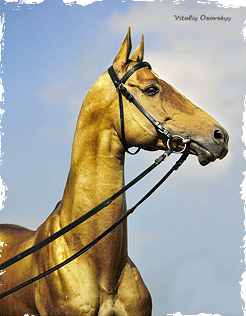
Akhal-teke horse is an real artwork of breeding, the result of work of many generations of horse breeders, a heritage of the great breeding culture of antiquities. Arminy Vamberi traveling across Central Asia in a XIX-th century, wrote: These beautiful animals cost all the work spent for them … Really, this animals are surprisingly valued by the sons of the desert more than their wives, more than their children,and more than their own life. Legends about their run and endurance are not exaggerated.
The history of this breed begins in the very ancient time, when numerous iranianspeaking tribes located on the territory of Central Asia, have started to breed horses, which would surpass all other in force and beauty. Ancient Iranians were familiar with a horse not by hearsay, they had a real cult of a horse. On the contrary, for a long time ancient civilizations neighbouring with Iranians had no horses, and the horses got into Mesopotamia, Ancient Egypt and other countries of the Middle East and the Mediterranean from Central Asia and Transcaucasia.
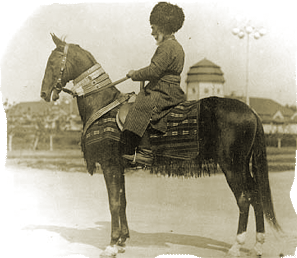 In old Russia Akhal-teke was known under a name of Argamak - however that was the name of any horse of east breed. Akhal-teke blood is in many Russian breeds - especially in Don and Russian Warmblood. Its contribution in East and West horse breeding is great. It is considered, that exactly Akhal-teke were among ancestors of English thoroughbred, which since a XIX-th century keep the first place on influence on other breeds. Akhal-teke influence in the history of formation of the Arabian breed is also traced (truly, in that time the modern name «Akhal-teke» not existed). According to the largest Soviet specialist of hippology V.O.Vitt, Akhal-teke breed is «gold fund of a cultural saddle horse of the whole world, last drops of that source of pure blood which has created all cultural breeds of horses».
In old Russia Akhal-teke was known under a name of Argamak - however that was the name of any horse of east breed. Akhal-teke blood is in many Russian breeds - especially in Don and Russian Warmblood. Its contribution in East and West horse breeding is great. It is considered, that exactly Akhal-teke were among ancestors of English thoroughbred, which since a XIX-th century keep the first place on influence on other breeds. Akhal-teke influence in the history of formation of the Arabian breed is also traced (truly, in that time the modern name «Akhal-teke» not existed). According to the largest Soviet specialist of hippology V.O.Vitt, Akhal-teke breed is «gold fund of a cultural saddle horse of the whole world, last drops of that source of pure blood which has created all cultural breeds of horses».
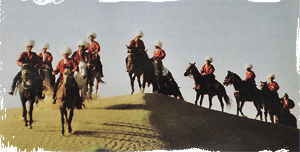
Turkmans were the big fans of races and concerned to training of horses very seriously. Experience in this business was transferred from generation to generation. The Soviet scientists investigating the Akhal-teke breed, noticed that the training system of Turkmen trainers (Seis) had a lot of common with system of training of English thoroughbred horses for racing on hippodromes in Europe. Actually Akhal-teke — one of the most fastest breeds in the world, and all conformation and abilities of this horse prove this.
During Soviet time Akhal-teke horses were bred not only in the Turkmenistan Soviet Republic, but also on territories of Kazakhstan, Tajikistan and Russian Soviet Republics. In this period breeding work has been fist of all directed on correction of existing lacks of conformation, and also on increase of height of horses. Today Russia have the main and the qualitative best livestock of Akhal-teke horses. Stavropol stud #170, Shael stud, Geli stud, Naib Idris stud and some studs of Dagestan, Kalmykia and Moscow Region are engaged in breeding of Akhal-teke horses .
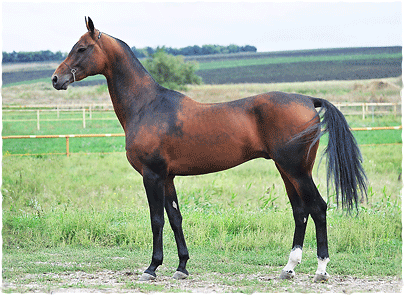 Modern Akhal-teke horse differs from that, who were 100, 300 and 1000 years ago only by higher height and more correct constitution. All unique features of breed, both external, and internal have been kept.
Modern Akhal-teke horse differs from that, who were 100, 300 and 1000 years ago only by higher height and more correct constitution. All unique features of breed, both external, and internal have been kept.
Features of the breed.
Life of Turkman consisted of constant military campaigns, raids, skirmishes, and quality of their horses was the practically life-and-death issue for them.
Akhal-teke horse has extremely fine mental organization. It is clever, proud and hasn't got used to parade its feelings. Its sympathy is necessary to be deserved, but to the one who will manage to become the friend of Akhal-teke, he will serve faithfully and will be ready to follow to his master in fire and water.
Akhal-teke is very good for riding, its movements are smooth and unfatiguing for the horseman.You can leave a child with Akhal-teke and be sure, that the horse won't cause any harm to the little horseman. But roughness or neglect will hurt Akhal-teke much more, than horses of any other breed, and it is able to stand up for itself. As well as other purebred horses, Akhal-teke in any way doesn't conform to a role of the «sport equipment» resignedly fulfilling any commands of the horseman, it demands the special approach. Therefore many sportsmen who have got used to more phlegmatic and compliant warmblood horses, consider Akhal-teke as a hard to work with. But in hands of the smart and patient horseman the Akhal-teke is able to make a real miracles.
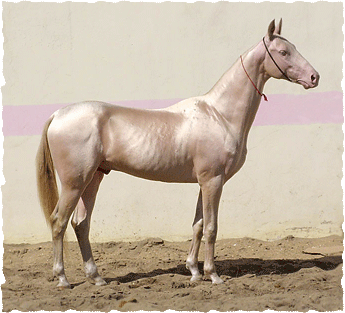 Color of Akhal-teke resembles golden color of sand dunes.
Color of Akhal-teke resembles golden color of sand dunes.
As a result of the selection Akhal-teke have got very rich and original set of colors: besides "usual" bay, chestnut, black and gray, there are rare clarified "yellow" colors: buckskin, palomino, perlino and cremello. One more feature of Akhal-teke colors - a wide spread of the bright golden shade meeting besides Akhal-teke only in Don, Boudenny, and Karabakh breeds, which have Akhal-teke blood.
Despite the thin soft skin and very short wool, the Akhal-teke horse can stand temperatures in a wide range — from -30 to +50 °C, and also serious differences of temperatures. It can frolic in the Russian snow same as in the Turkmen sand.
External frailty of breed hides the improbable endurance. As historians say, there were cases when the wounded in fight by sabre Akhal-teke carried away two adult men on its back, leaving with them on quicksand. And today endurance of Akhal-teke breed was confirmed repeatedly by the record days-long trips and sport journeys.
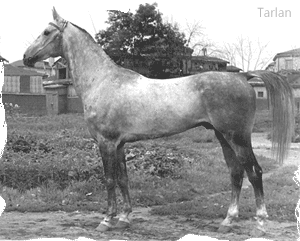
The most famous endurance ride on Akhal-teke has taken place in 1935 on a route Ashkhabad-Moscow. This distance has been passed in 84 days, and the sands of Kara Kum desert the horsemen have crossed in three days without any stop for meal, drink or a sleep. All horses remained healthy and have reached Moscow.
As a real horses of a desert, Akhal-teke easily stand thirst. After all in a desert to get from a well to a well they often had to cross 100—150 km in a day.
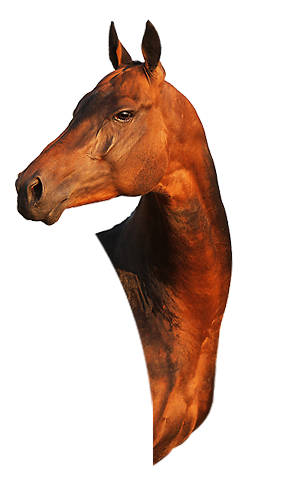


 © 2023
© 2023